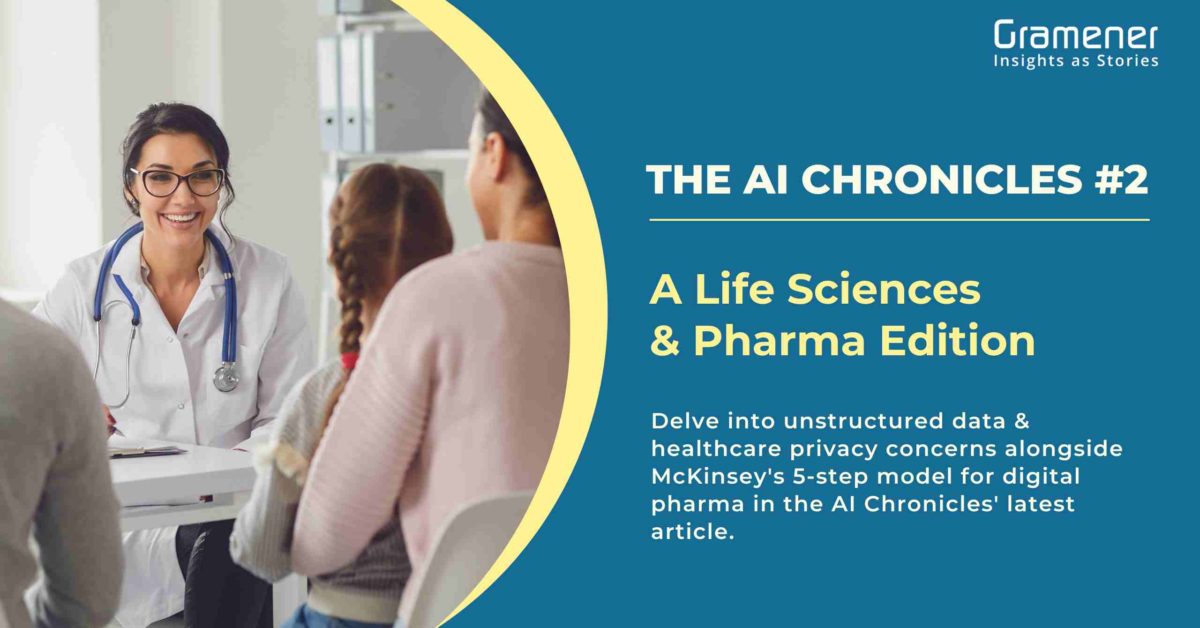Welcome back to the AI Chronicles Series! Don’t forget to explore the other three episodes of the series.
- The AI Chronicles #1 – What’s hot in the pharma world with Generative AI, how to build robust patient data privacy, and what’s up with Apple’s AI-powered health coach.
- The AI Chronicles #3 – Find content in images and videos with Microsoft’s Vector, Washington’s new health privacy law, and the importance of personalization in healthcare.
- The AI Chronicles #4 – AI Chronicles #4: AWS HealthScribe revolutionizes clinical documentation, Roche’s report underscores digital tech and data management, and Pytrial aids clinical trials with Generative AI.
In the second article of the AI Chronicles series, we explore the definition of unstructured data amidst growing concerns around data privacy in healthcare. Also, as the discussion around digital pharma models moves towards more maturity, we spotlight McKinsey’s five-step model on pharma for the digital age.
Table of Contents
GDPR, Healthcare Data, and De-identification
What is it About?
The digitization of medical data has transformed healthcare through efficient information sharing, leveraging electronic health record systems. However, it has simultaneously raised privacy and security concerns surrounding sensitive medical information. This article by Weitzenboeck et al. goes into an interesting challenge – the EU’s General Data Protection Regulation (GDPR) requirements lack a definition of ‘anonymous data’ and describe two case studies concerning unstructured data.
What Does it Mean?
Unstructured data, such as text documents or images, is far more common than structured data, and the legal requirements that must be fulfilled to anonymize such data formats properly remain unclear and under-addressed by the literature. The paper highlights some of the technical challenges encountered with the anonymization of unstructured data, including the implicit and ambiguous mapping between the dataset itself and the personal information it may convey. The anonymization of unstructured data requires the use of dedicated techniques that are often markedly different from the ones employed for other types of high-dimensional data.
McKinsey’s Take on Rewiring Pharma for Digital Age
What is it About?
The initial excitement of digital technology and transforming the traditional business models of pharma/device companies has slowed down, and organizations are getting more practical. McKinsey rightly points out the current state in a recent review.
“Pharmaceutical companies have only scratched the surface. Siloed use cases and impact stories abound, but investments have rarely led to profound organizational changes. Few have yet succeeded in deeply embedding digital and analytics throughout their organizations. Executives are growing frustrated by the lack of broader, transformational impact.”
What Does it Mean?
McKinsey suggests five steps to move from ‘small-scale experimentation to the industrialization of digital and analytics.’
- Rethink operating models and reorient around outcomes by reassessing commercial-organizational models and implementing high-value stakeholder-engagement initiatives.
- Dive into DataOps to drive innovation by focusing on key industry capabilities such as machine learning at scale.
- Industrialize AI with MLOps by reimagining the pharmaceutical company of the future, powered by intelligent technologies across the enterprise.
- Rapidly transform talent strategies by fundamentally shifting mindsets, boosting skill sets, and building up toolkits to achieve the level of sophistication required to succeed.
- Define a digital health strategy by tech-enabling the organization and advancing the portfolio to achieve multiple objectives simultaneously.
Sanofi’s route to AI Adoption
What is it About?
More and more operations and businesses within healthcare companies, including pharmaceutical and medical device organizations, are digitizing at a varied pace. Sanofi recently launched an AI-powered app to support its employees across different areas. The app uses AI to provide personalized recommendations to employees based on their needs. The app is designed to help employees work more efficiently and effectively and to provide them with the support they need to succeed. The app is part of Sanofi’s broader digital transformation efforts, which include the use of AI and other technologies to streamline operations and improve patient outcomes.
What Does it Mean?
It will be interesting to see the outcomes of these tools that are being developed and delivered to internal organizations in healthcare. Traditionally, pharma/medical device companies have been slow to show results from their digital transformation activities, a key reason being the difficulty in scaling up digital and automation solutions.
Read the 1st Part of the AI Chronicles: A Life Sciences & Pharma Edition
The Gramener Take
As digitization and the opportunities that come along with it in data integrations, advanced analytics, and business operations continue to expand, at Gramener, we continue to work with our client partners in defining and guiding the right approach to their digital transformation initiatives. With our domain expertise in pharma, medical devices, and healthcare organizations, we are able to tease out a broader and deeper understanding of the value propositions of these digital transformation activities.
Gramener helps healthcare organizations adopt a culture of data and maximize the impact of their data projects. From advisory to the implementation stage, our offerings enable organizations to align their data strategy to their business needs, identify major data projects, and establish data and analytics teams. Read more about our advisory offerings.
At Gramener, we continue to invest in fine-tuning various techniques of de-identifying healthcare data. Manual redaction & anonymization in the pharmaceutical industry is expensive, laborious & error-prone. For compliance requirements with regulatory agencies like EMA (EMA Policy 0070) and Health Canada PRCI, it is essential that de-identification meets standards set in their regulations, working with a combination of structured and unstructured datasets. Gramener’s product-AI-anonymize brings together cutting-edge AI, user-centered Design, and expert regulatory compliance algorithms to simplify compliance with the evolving stringent global regulatory disclosure & submission rules. We are constantly innovating to make this process much more adaptable and compliant with evolving privacy requirements across the world.

